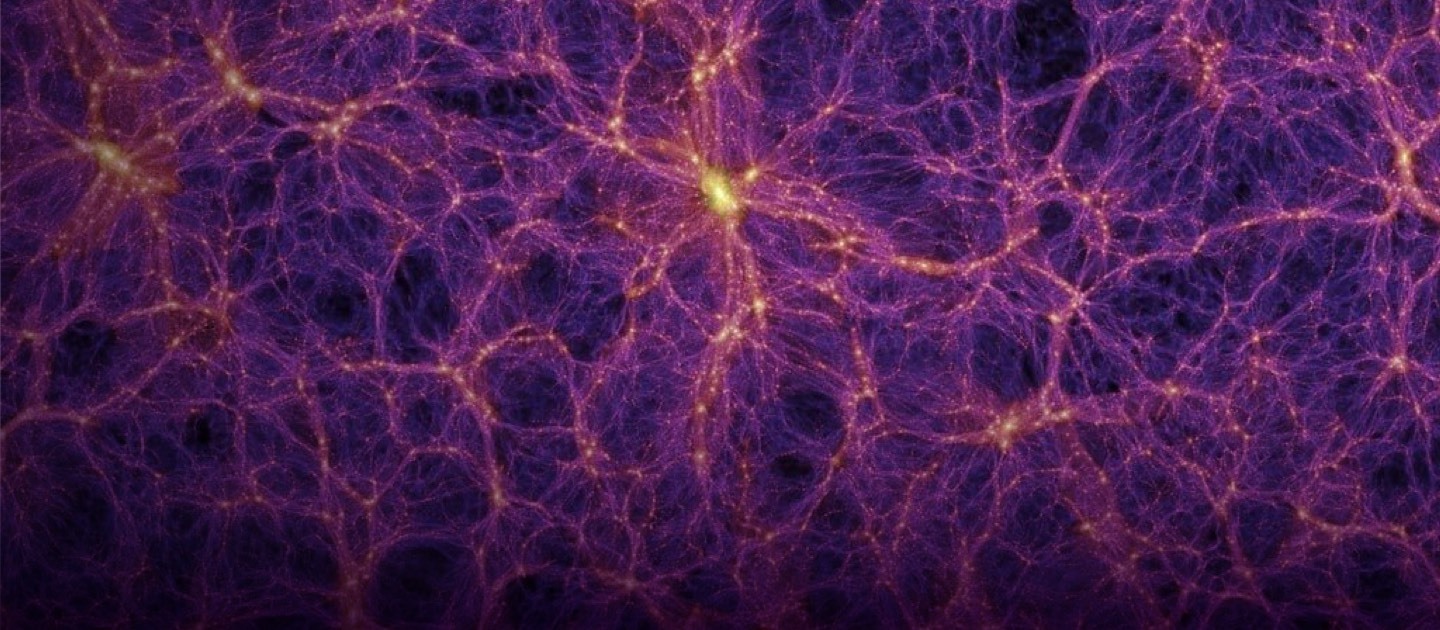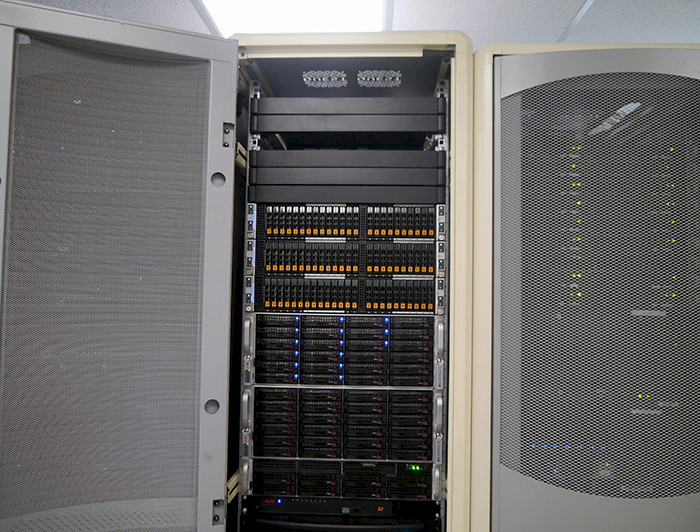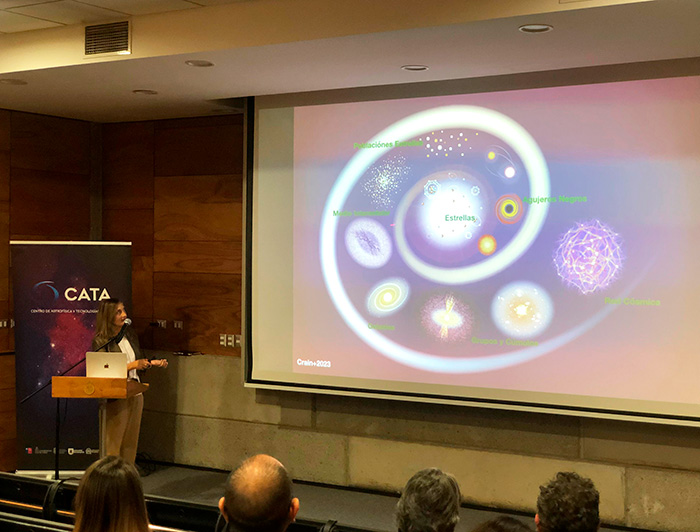
New Supercomputer Bolsters Chile's Astronomical Observation Capabilities
Funded by the Center of Excellence in Astrophysics and Associated Technologies (CATA, as per its Spanish acronym) and installed at the UC Institute of Astrophysics, Geryon 3 stores large amounts of data and performs simulations that can be used to investigate how galaxies are formed. While its primary focus is astronomy, it will be available to a range of disciplines spanning from physics to biology, catering to both academic and industrial sectors, thereby enriching the country with advanced technology.

photo_camera "To complement our observational capabilities, we will need a strong group of theorists who can help interpret the results of the experiments and enrich the research," said Physics Faculty Dean Samuel Hevia about the importance of having this new supercomputer. (Photo by: María José Julián).
By the 2030s, Chile will have the largest astronomical observation capacity in the world. New observatories, such as the Giant Magellan Telescope (GMT), the European Extremely Large Telescope (E-ELT), and the Vera C Rubin Observatory will be added to the existing infrastructure. The latter will have the world's largest digital camera for optical astronomy with a resolution of 3,200 megapixels (a professional camera averages between 20 and 50 megapixels) and will photograph the southern hemisphere sky every three to four nights, capturing some 1,000 giant images per night.
How is all this information processed? With supercomputers! However, their numbers are limited worldwide, totaling just over a thousand, primarily concentrated in countries such as China, the United States, Japan, France, and Germany, among others.
Chile hosts the National Laboratory of High Performance Computing (NLHPC), home to the Guacolda-Leftraru supercomputer. With a capacity of 25 thousand computers, it stands as the most potent in the country and one of Latin America's foremost. While not exclusively dedicated to astronomy, it serves various fields of knowledge and institutions, both public and private, nationwide.
Named after a mythical Greek king with three bodies, Geryon 3, is the largest supercomputer in Chile dedicated to astrophysics, providing a platform for both academics and students to carry out their research.
This new equipment, which required an investment of over 350 million Chilean pesos (367,500 USD approximately), fulfills a long-awaited dream of the Center for Astrophysics and Related Technologies (CATA), formed by University of Chile, UC Chile, University of Concepción, University Diego Portales, and University Andrés Bello. It was inaugurated in a ceremony led by the new Dean of the Faculty of Physics, Samuel Hevia, alongside authorities, academics, and researchers from both UC Chile and the CATA center.
"To complement our observational capabilities, we will need a strong group of theorists who can help interpret the results of the experiments and enrich the research. The simulations team, which is part of CATA and UC Chile, is working to fill this gap, supported by instruments such as the supercomputer we are seeing today. I am sure Geryon 3 will be a fundamental pillar in developing the UC Institute of Astrophysics and the CATA community," said Dean Samuel Hevia.
"The acquisition of the Geryon 3 supercomputer substantially boosts our computational capabilities. This will enable us to analyze the vast data sets from the new mega telescopes and conduct more advanced simulations. Ultimately, it will deepen our comprehension of the physical phenomena occurring in the universe," said CATA Director Guido Garay.
A Drive for Exploration

Located at the UC Institute of Astrophysics on the San Joaquin Campus, in Santiago, the capital city of Chile, the new equipment occupies a 36-square-meter room equipped with a technical floor. It is cooled by a specially designed refrigeration system and includes other technical features such as electric current stabilization.
This is also where its counterpart, Geryon 2, has operated for almost a decade, facilitating extensive research that has yielded 131 scientific articles and over 1,800 citations in publications. It has been an incremental journey since the arrival of the first Geryon in 2008, followed by its predecessor, a 4-node, 64-core supercomputer in 2003, and previous computational efforts.
With 12 nodes, each with 64 cores and 512 GB of memory -providing 768 cores in total-, the Geryon 3 supercomputer marks a significant milestone in the advancement of computational capacity for astrophysical research in Chile, expanding by more than 4 times its potential for information processing.
According to the Director of the Institute of Astrophysics Felipe Barrientos, with this equipment it is possible "to interpret the observations that we obtain from the large observatories in Chile; we need models and a theory to explain them. This modern computer is essential for researchers to test different models and make predictions for new observations. In this way, our understanding of the universe advances step by step."
Geryon 3 will primarily focus on storing vast data volumes and conducting simulations, such as modeling the formation of galaxies.
"Unlike physicists, who can take two atoms and make them collide to see what happens, we astronomers can't do that, we can't take two planets and crash them! That's why we need to do simulations," explained Ezequiel Treister, an academic at the Institute of Astrophysics and CATA's Deputy Director. Moreover: "The simulations allow you to do processes that would take millions of years, on gigantic scales; you put them in the computer and see what happens."
The expert in high energies and black holes points out that although there are supercomputers much larger than Geryon 3 in the world, this new equipment provides the possibility of exploring unstudied areas, testing, and "making mistakes", which is fundamental in science. It also serves to train and educate students and young researchers, providing valuable experience before they access larger supercomputers in Europe or the United States.
Not Just Astronomy
While Geryon 3 will focus on astronomical exploration, it is also intended to offer its calculation service to different initiatives that require processing huge volumes of data, in fields as diverse as mining, renewable energies, biogenetics, or forestry engineering.
The aim is for the team to become an "active collaborator, with state-of-the-art technology, to develop projects that are linked to process improvement, decision making, and beneficial actions for society. With this, we tackle issues of both national and, why not, international importance, addressing questions and resolving them promptly,” said Patricia Tissera, professor at the UC Institute of Astrophysics and principal investigator at CATA center.
As Ezequiel Treister added, "We are interested in demonstrating that this is an investment that benefits not only astronomy but also holds the potential to enhance industrial processes and broaden our horizons.”
Thus, the implementation of this computational tool not only represents a boost in the technology infrastructure available to the country's astronomical community but also marks the strategic importance of having state-of-the-art resources at a time when the amount and complexity of data is growing exponentially.


